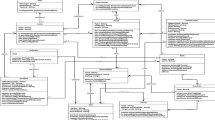Abstract
A fuzzy cognitive model of industrial emergencies is proposed. The model permits analysis of possible measures for risk reduction and the elimination of emergencies and accidents at industrial enterprises. The relationships among and within groups of concepts in the fuzzy cognitive model are established. The applicability of the new fuzzy cognitive model is discussed.






Similar content being viewed by others
REFERENCES
Andreeva, O.N., Fuzzy ontological model for the monitoring of technogenic disturbances, Vopr. Radioelektron., 2016, no. 9, pp. 103–107.
Andreeva, O.N., Risk monitoring of technogenic violations and emergency situations, Naukoemkie Tekhnol., 2017, vol. 18, no. 3, pp. 85–91.
Borisov, V.V., Kruglov, V.V., and Fedulov, A.S., Nechetkie modeli i seti (Fuzzy Models and Networks), Moscow: Goryachaya Liniya-Telekom, 2012.
Zuev, V.V., Shmeleva, A.G., Kalenyuk, I.V., and Rumyantsev, R.A., Software for analysis of irreversible events in constructions and buildings under dynamic loads, Vestn. Mosk. Gos. Tekhnol. Univ., MIREA, 2015, nos. 3–2 (8), pp. 99–109.
Romanov, A., Romanov, M., Kharchenko, A., and Kholopov, V., Unified architecture of execution level hardware and software for discrete machinery manufacturing control systems, Proc. 2016 IEEE Student Conf. on Research and Development (SCOReD), Piscataway, NJ: Inst. Electr. Electron. Eng., 2016, p. 7810088. https://doi.org/10.1109/SCORED.2016.7810088
Romanov, M.P., Romanov, A.M., Kashirskaya, E.N., et al., A novel architecture for the executive-level control systems for a discrete machinery production, Mekhatronika, Avtom., Upr., 2017, vol. 18, no. 1, pp. 64–72.
Chizhikov, V.I., Engineering of elastic kinematic joint of hingeless manipulator for technological operations in shielded environment, Avtom. Sovrem. Tekhnol., 2013, no. 5, pp. 32–40.
Albagachiev, A.Yu. and Kushnir, A.P., New generation devices for water jet processing, Trudy IV Mezhdunarodnoi nauchnoi konferentsii “Fundamental’nye issledovaniya i innovatsionnye tekhnologii v mashinostroenii” (Proc. IV Int. Sci. Conf. “Fundamental Studies and Innovative Technologies in Machine Engineering”), Moscow: Spektr, 2015, pp. 24–27.
Silov, V.B., Prinyatie strategicheskikh reshenii v nechetkoi obstanovke v politike, makroekonomike, sotsiologii, menedzhmente, meditsine, ekologii (Strategic Decision-Making in Fuzzy Environment in Policy, Macroeconomics, Sociology, Management, Medicine, and Ecology), Moscow: INPRO-Press, 1995.
Festinger, L., A Theory of Cognitive Dissonance, Redwood City, CA: Stanford Univ. Press, 1957.
Author information
Authors and Affiliations
Corresponding author
Additional information
Translated by Bernard Gilbert
About this article
Cite this article
Andreeva, O.N., Kurnasov, E.V. Fuzzy Cognitive Model for Identification of Destabilizing Factors. Russ. Engin. Res. 39, 399–406 (2019). https://doi.org/10.3103/S1068798X19050034
Received:
Revised:
Accepted:
Published:
Issue Date:
DOI: https://doi.org/10.3103/S1068798X19050034




